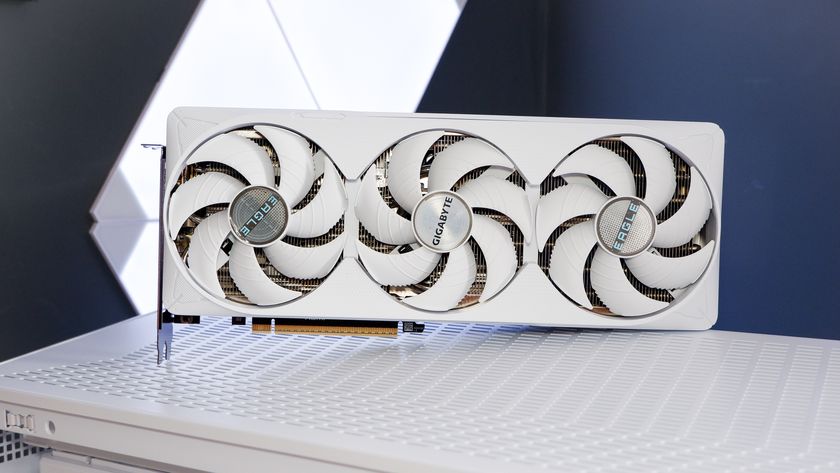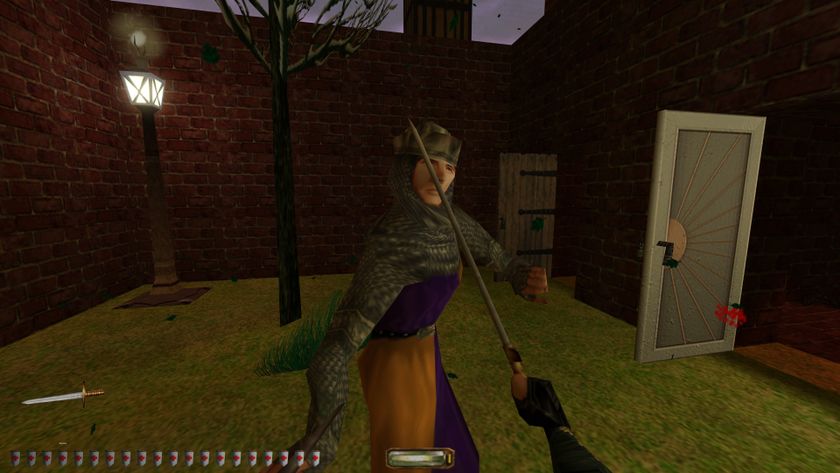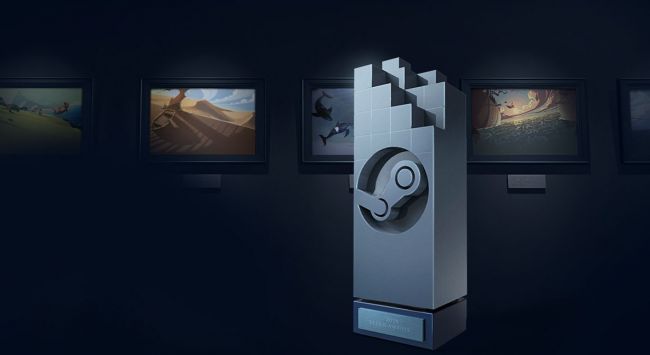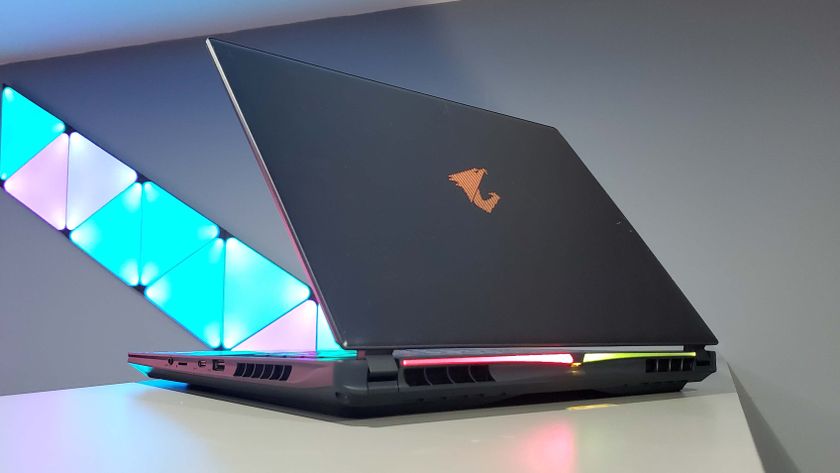Hardware report card: Nvidia vs AMD
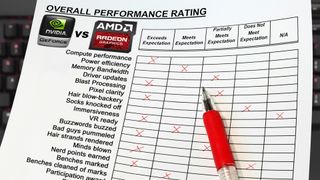
The AMD R9 Fury X is here, marking the first time since 2013 that both AMD and Nvidia have had new, competitive GPU hardware out at the same time. The GTX 980 Ti and the Radeon R9 Fury X are both priced at $650 and aimed at high-end 1440p and 4K gaming. The Fury X represents a huge release for AMD, while Nvidia’s been releasing a steady stream of Maxwell graphics cards since late 2014. Against that backdrop, we thought it was time for a check-in: where do AMD and Nvidia stand right now, where are they going, and most importantly, whose graphics cards should you buy?
First off, neither company deserves your abiding loyalty. Don’t blindly follow AMD or Nvidia from one graphics card release to the next, singing their praises over the competition. It should go without saying that you should head where the best product is. And when we’re talking graphics cards, the best product isn’t just about hardware. It's about driver performance and updates. It's about software and exclusive features. And it's about the accessories that work with those graphics cards, like G-Sync and FreeSync monitors.
In this feature I've taken a look at each of these areas and graded AMD and Nvidia on how they stand right now. Here are the categories; click a link to jump to the page in question.
Report card table of contents
The graphics cards
Graphics driver updates and performance
Graphics driver software
Exclusive features: Gameworks and TressFX
FreeSync vs. G-Sync
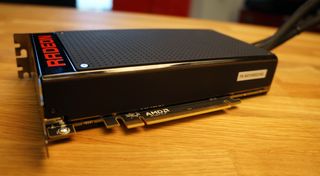
The graphics cards
It can be tough to keep track of every card in the GPU market. Here are the ones you should know about right now, divided into some rough performance tiers. I’ll talk about how Nvidia and AMD cards match up in performance and price beneath each chart.
High-end
| Specs | R9 Fury X | GTX 980 Ti | GTX Titan X | GTX 980 |
| VRAM | 4GB HBM | 6GB GDDR5 | 12GB GDDR5 | 4GB GDDR5 |
| Stream processors/CUDA | 4096 | 2816 | 3072 | 2048 |
| Base clock | 1050 MHz | 1000 MHz | 1000 MHz | 1126 MHz |
| Boost clock | 1050 MHz | 1075 MHz | 1075 MHz | 1216 MHz |
| Memory clock | 500 MHz (1 GHz effective) | 1750 MHz (7GHz effective) | 1750 MHz (7GHz effective) | 1750 MHz (7GHz effective) |
| Memory bandwidth | 512 GB/s | 336 GB/s | 336 GB/s | 224 GB/s |
| Texture units | 256 | 176 | 192 | 128 |
| ROP units | 64 | 96 | 96 | 64 |
| Compute | 8.6 TFLOPS | 5.6 TFLOPS | 6.14 TFLOPS | 4.6TFLOPS |
| TDP | 375W | 250W | 250W | 165W |
| Price | $650 | $650 | $1000 | $500 |
The biggest gaming news, reviews and hardware deals
Keep up to date with the most important stories and the best deals, as picked by the PC Gamer team.
| Specs | R9 390X | R9 295X2 |
| VRAM | 8GB | 4GB x 2 |
| Stream processors/CUDA | 2816 | 2816 x2 |
| Base clock | 1050 MHz | 1018 MHz |
| Boost clock | 1050 MHz | 1018 MHz |
| Memory clock | 1500 MHz | 1250 MHz |
| Memory bandwidth | 384 GB/s | 320 GB/s x 2 |
| Texture units | 176 | 176 x2 |
| ROP units | 64 | 64 x2 |
| Compute | 5.9 TFLOPS | 11.5 TFLOPS |
| TDP | 275W | 500W |
| Price | $429 | $630 |
AMD releasing the R9 Fury X at $650 was an aggressive move, matching the 980 Ti at the high-end. The Fury X’s power usage is right in line with the 980 Ti, which is a great improvement over AMD’s last generation of cards. And it comes very close on performance, but not quite close enough for us to recommend it over the 980 Ti. Improved drivers may give the Fury X a performance edge, but currently it’s lacking overclocking potential and frametime consistency, and the 4GB of memory is going to be a limitation in future games. As our colleagues at Maximum PC summarized, “Fury X looks great on paper, but it needs fine-tuning and drivers to realize its potential.”
The 980 Ti, meanwhile, is a much smarter buy than the more expensive Titan X, offering very similar performance for $450 less. The 6GB framebuffer is ample for most of today’s games even at 4K, and by the time you’re actually using 12GB of VRAM, you’ll probably want a newer, faster card than the Titan X. The other extremely high-end option is AMD’s R9 295X2, a dual-GPU card that can still slightly outperform the mighty Titan X, and now costs only $630. That’s a ton of performance for the price, but it has drawbacks. As we covered in our Titan X review, the dual-GPU 295X2 posts lower minimum framerates with some severe frametime stuttering problems (you can see better evidence of this at The Tech Report), draws huge amounts of power, and needs some serious cooling to stay operational. It’s a beast of a card, but from an efficiency standpoint, the 980 Ti and Titan X are better buys.
Finally, we’ve got the GTX 980 and the R9 390X. AMD’s new 300 series cards are actually refreshes of the previous 200 series graphics cards, using the same GPU technology. The GPUs are old, but AMD has made some tweaks, including adding memory up to 8GB on the 390X (and the 390, which we’ve put in the mid-range category) and clocked that memory 20 percent faster than the otherwise very similar 290X. GPU clocks are also up a bit, and AMD's also done some under-the-hood tweaking to power management and done work on the driver side to improve performance over the 200 series.
As Maximum PC’s review of the 390X shows, the card comes close to the GTX 980’s performance, as the 290X did before it...but the GTX 980 is a much stronger overclocker, while running quiet and drawing far less power.
The 390X is priced aggressively, and the 8GB of VRAM is a nice touch, but it’s hard to say how valuable it will be. The 390X is definitely a card better suited to high-end 1080p and 1440p gaming than 4K gaming, where that extra memory is especially valuable. You could save even more money by buying an older 290X with 4GB of memory if you’re gaming at 1080p.
While we don’t know what Nvidia cards will be coming to market in the next six months, we do know that AMD has the R9 Fury coming in July, which is $100 cheaper than the Fury X. They’re the same cards, but the Fury is air-cooled instead of liquid cooled. There’s also the small form-factor Fury Nano, and a dual-GPU Fury, coming in the fall. Those cards will give AMD a much stronger line-up, and at $100 cheaper than the 980 Ti, the R9 Fury will potentially be a great high-end buy.
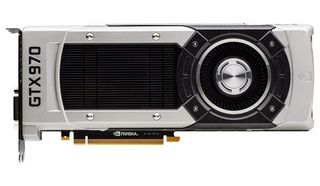
Mid-range
| Specs | GTX 970 | R9 390 |
| VRAM | 4GB (3.5GB full bus-speed) | 8GB |
| Stream processors/CUDA | 1664 | 2560 |
| Base clock | 1005 MHz | 1000 MHz |
| Boost clock | 1178 MHz | 1000 MHz |
| Memory clock | 1750 MHz | 1500 MHz |
| Memory bandwidth | 196 GB/s (3.5GB)28 GB/s (512MB) | 384 GB/s |
| Texture units | 104 | 160 |
| ROP units | 56 | 64 |
| Compute | 4 TFLOPS | 5.1TFLOPS |
| TDP | 145W | 275W |
| Price | $330 | $329 |
AMD matched the price of the GTX 970 with its R9 390, which, like the rest of the 300 series, is a slightly tweaked version of the older 200 series cards with 8GB of VRAM. Its core clock is a bit higher, and its memory clock is increased 20 percent.
Price-wise, 8GB of VRAM at $330 is a hell of a bargain. Still, the GTX 970 vs. the 390 is pretty much the same as the GTX 970 vs. the 290: it’s going to win on overclocking, volume and power efficiency with slightly better performance. And neither card is suited to 4K gaming, which is where more VRAM is especially valuable. The GTX 970 is the better card, though it’s possible that, two years from now, its 3.5GB of full-speed memory will be a limiting factor in memory-hungry games.
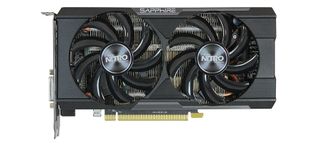
Low-end
| Specs | GTX 960 | R9 380 | R7 370 | R7 360 |
| VRAM | 2GB / 4GB | 2GB / 4GB | 2GB / 4GB | 2GB |
| Stream processors/CUDA | 1024 | 1792 | 1024 | 768 |
| Base clock | 1127 MHz | 970 MHz | 975 MHz | 768 MHz |
| Boost clock | 1178 MHz | 970 MHz | 975 MHz | 768 MHz |
| Memory clock | 1752 MHz | 1375 MHz / 1425 MHz | 1400 MHz | 1625 MHz |
| Memory bandwidth | 112 GB/s | 182.4 GB/s | 179.2 GB/s | 104 GB/s |
| Texture units | 64 | 112 | 34 | 48 |
| ROP units | 32 | 32 | 32 | 16 |
| Compute | 2.3 TFLOPS | 3.48 TFLOPS | 2 TFLOPS | 1.61 TFLOPS |
| TDP | 120W | 190W | 110W | 100W |
| Price | $199 / $240 | $199 / $220 | $149 / $180 | $109 |
In the realm of cheaper graphics cards, AMD overwhelms Nvidia with options. The GTX 960 is a good card, and its Maxwell GPU will draw less power than the AMD GPUs while delivering much better performance than the R7 370 and 360, which are very much budget cards. The R9 380 outperforms it by about 5 - 10 fps, according to Tom’s Hardware’s tests, though the GTX 960 can close some of that gap by overclocking.
Thankfully, there are 4GB versions of both the GTX 960 and the R9 380, which we’d recommend: 2GB of VRAM just isn’t enough these days. The R9 380 is a strong performer for its price, and the better bargain overall, though for a budget build, you may need a stronger power supply than you’d buy for a GTX 960 setup.
Nvidia: A
Nvidia’s Maxwell GPU is power efficient and fantastically overclockable, with a hard-to-beat option in each pricing tier.
AMD: B
The new Fury X is strong, but the rest of AMD’s aging, rebranded cards are outmatched against the more efficient Nvidia GPUs, though priced well. AMD’s Fury cards coming in the fall may help level the field.
Report card table of contents
The graphics cards
Graphics driver updates and performance
Graphics driver software
Exclusive features: Gameworks and TressFX
FreeSync vs. G-Sync

Wes has been covering games and hardware for more than 10 years, first at tech sites like The Wirecutter and Tested before joining the PC Gamer team in 2014. Wes plays a little bit of everything, but he'll always jump at the chance to cover emulation and Japanese games.
When he's not obsessively optimizing and re-optimizing a tangle of conveyor belts in Satisfactory (it's really becoming a problem), he's probably playing a 20-year-old Final Fantasy or some opaque ASCII roguelike. With a focus on writing and editing features, he seeks out personal stories and in-depth histories from the corners of PC gaming and its niche communities. 50% pizza by volume (deep dish, to be specific).
